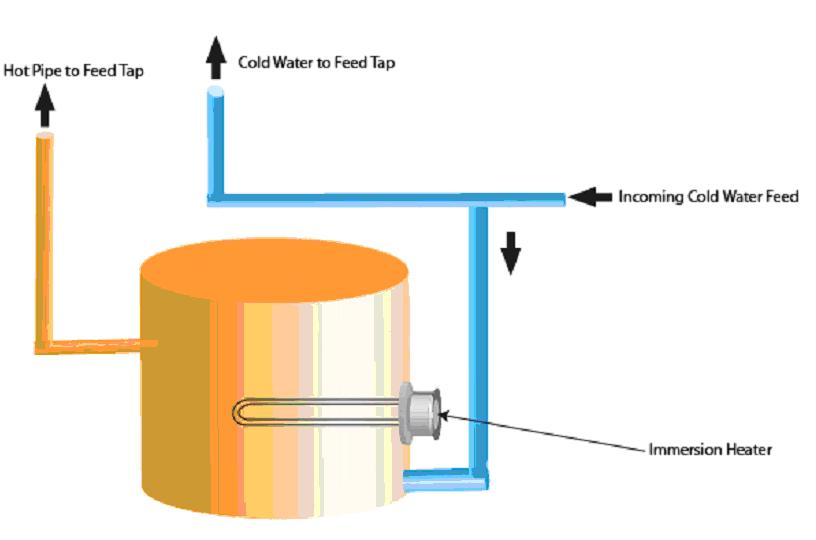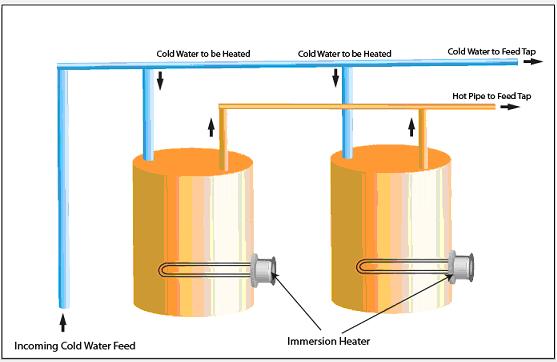Hot Water Heater Elements
Last updated on September 3rd, 2023 at 02:07 pm
Hot Water Heater Elements
Hot water is a high demanding resource for residential, commercial and industrial use. There are many techniques to heat water quickly, most notably by natural gas, oil and electric heaters (see source 1). Gas and oil sources are tend to be more expensive than electricity because of the higher operating and installation cost and for that reason, the electrical water heating is generally the popular choice for home and business use. It is generally more convenient to use electrical water heater because the only requirement is the availability of an electrical source which is available in nearly all rural areas.
Electrical water heating is a commonly used technique for supplying hot water in the United States and Canada. With this type of heating, certain volume of water is pre-heated and stored in a cylindrical tank so that it is available for use (Figure 1).
The electric heating process is commonly done inside a small or medium size water tank where the liquid is heated internally or externally. The heated water is then ready to be delivered to the consumers’ water tap.
An illustration of a domestic water storage tank with an immersion heater is shown in Figure 1. In this process, incoming cold feed water from the municipal well enters system and fills up the hot water cylinder. Using an immersion heater is a cost and energy efficient way to pre-heat water in short period. The water immersion heater is installed near the bottom of the tank in order to pre-heat the entire cylinder before delivering to the consumer’s water tap. This type of heater consists of a heating element that is made by a metallic sheath material which wraps a Nickel Chromium resistor together with Magnesium Oxide (Figure 2).
The hot water immersion heater manufactured by WATTCO™ consists of one or more heating elements which are inserted into the wall of a liquid tank. The hot water heater elements will have direct contact with the liquid medium of the tank. The heating process of the water immersion heater initiates by adjusting the desired temperature, then the enclosed resistor of the hot water heater elements begins to generate the heat which dissipates across the surface of the heater elements.
The selection of WATTCO™’s water immersion heater is based on the target application. For example, for hot water application, the sheath material selection is recommended to be Incoloy™ in order to obtain the maximum performance and to also extend the durability of the hot water heater elements. WATTCO™ recommends our customers to provide information concerning the details of the heater usage (such as tank dimension, desired temperature and volume) to ensure that the hot water heater will perfectly fit in the cylinder. In addition, there is more than one type of immersion heaters that can be considered for hot water heating application. Flanged heater type, which is generally mounted on the side wall of the cylinder, is recommended to be used for larger storage tank. A screw plug type, which is directly screwed on the cylinder wall, provides the necessary heat for smaller size tank and this type is ideal for domestic hot water system.
Hot water immersion heaters are not limited for domestic use, but they can be used in any industry that requires hot water supply. For example, in the agricultural industries, the water heating process is important since the hot water demand is very high for many purposes. For instance, for a milk production facility, the pipeline and milking equipment cleaning process requires the water supply temperature to be at least 120°F for proper sterilization (see source 2). In this type of industry, the heating process can be done in a similar fashion to the domestic hot water system where the water is stored in a large tank and the liquid is then heated by the water heater elements continuously.
For applications that require larger volume of hot water, a supplemental hot water tank can also be installed in parallel with the main unit in order to continuously provide high hot water quantity (see source 3). This parallel configuration is shown on Figure 3, where multiple water tanks can be joined in parallel to provide the maximum amount of hot water supply.
Figure 3 – Parallel Configuration of a Hot Water System
WATTCO™ can also provide additional customization on the hot water heater elements such as selection over different bending, length, material, etc. The shape of the immersion heater or heater elements can be adjusted to ensure the compatibility with the dimension of the applied water tank. WATTCO™’s technical consultants are always available to help on the selection of a suitable hot water heater for your application.
References
1. “Types of Water Heaters.” Office of Energy Efficiency. Natural Resources Canada, 23 Aug. 2011. Web. 10 Nov. 2011.
2. Dunlop, Carson. Principles of Home Inspection: Systems & Standards (2003) Dearborn™ Real Estate Education, U.S., ISBN 978-0793179350, p. 802



